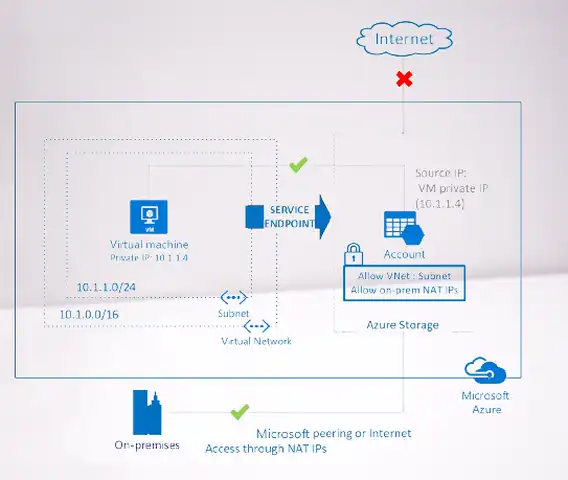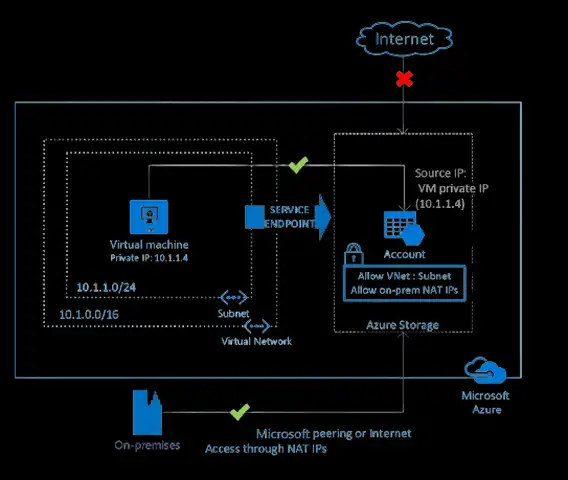Azure Service Endpoint is a powerful new feature in Azure that provides an easy way to create and manage web applications on the cloud. In this blog, we’ll explain what an Azure Service Endpoint is, what the benefits are, how you can create one, and some of the limitations. Finally, we’ll show you how to configure the service endpoint in Azure.
What is an Azure Service Endpoint?
Azure Service Endpoint is a cloud-based service that enables you to manage your applications, services, and customers from one place. It connects your applications with cloud-based services for managing them and making them accessible from anywhere.
Azure Service Endpoint helps you improve application performance by caching the frequently accessed data. This helps reduce the load on your database and improves the responsiveness of your website or app. In addition, Azure Service Endpoint can help monitor traffic patterns, optimize resource usage, detect security threats early, diagnose errors quickly, and much more!
What are the benefits of using an Azure Service Endpoint?
Security is one of the most important benefits of using an Azure Service Endpoint. You can securely connect to and manage your cloud-based applications from a single location with an endpoint. This enables you to quickly deploy new features or fixes to your cloud-based applications without having to redeploy them entirely.
Moreover, service endpoints offer enhanced compliance with regulatory requirements like GDPR and SOX since they allow for secure communications between your organization’s data center(s) and the cloud. And finally, service endpoints can help improve application performance by ensuring that requests are routed quickly and efficiently through the system.
Read Also: Azure App Service: The 5 Best Way to Build and Manage Applications
How to create an Azure Service Endpoint?
Azure Service Endpoints are a web application that allows you to secure your website and share files with authorized users.
They work like an extension for your website, providing encrypted file sharing for secure file sharing. You can create an Azure Service Endpoint in minutes by following these simple steps:
- 1) Log into the Azure portal
- 2) Click on Services
- 3) On the left side menu under Web Applications, click on Create New Web Application
- 4) Select Online from the Type dropdown list and enter a name for your web application (e.g., My WebsiteAzureServiceEndpoint )
- 5) Under Settings, select Enable Gates Access and Authorize Users From Another Site as needed
- 6) Select SSL or Choose Your Certificate from The Server Certificate Store. If you’re using Let’s Encrypt, select Use TLS/SSL. If you don’t want to use encryption, deselect this checkbox (you will still be able to access the web application, but no one else will be able to do so). Then click onCreate button
- 7 ) Go back to the services pane and find your newly created web app labeled “My WebsiteAzureServiceEndpoint” Check to mark its status as Enabled
Limitations
Azure Service Endpoint is a great option for managing Lync Server and SharePoint Online, but it has some limitations.
Azure Service Endpoint can be used for managing Lync Server and SharePoint Online.
You can also use Azure Service Endpoint to help automate your communication processes by automating the routing of email messages to specific recipients in your organization.
However, there are a few limitations that you should be aware of:
First, Azure Service Endpoint cannot handle high volumes of traffic or large files; if your organization needs to manage these types of tasks with Azure.
How to configure service endpoint in Azure

To configure Azure Service Endpoint, you need to create a service, specify the exposed endpoint, and specify your authentication scheme.
To create a service: Open the Azure portal and select Active Directory Services > directory services > active directory tenant. In the navigation pane on the left side of the page, click New cloud resource ->service instance -> web applications and then enter a name for your new service (for example, MyWebApp).
On the Settings tab at the top of the screen, choose General, as shown in figure 1. Under Select, an existing template, select Web App with HTTPS binding, as shown in figure 2.
- Figure 1: The settings tab for creating a new service
- Figure 2: Selecting “Web App with HTTPS binding” from available templates on the setting tab.
Considerations
As businesses increasingly move their operations to the cloud, they need to take into account Azure Service Endpoints. Azure Service Endpoints provide a secure way for your business to connect to cloud-based services and applications.
They also make it easy for you to manage your connections and deployments, as well as monitor your usage and performance. In this article, we’ll discuss some of the considerations you should make when deciding whether or not Azure Service Endpoints are right for your organization.
- First and foremost, consider how much control you want over your connection setup and deployment process. With Azure Service Endpoints, you can choose between on-premises or hosted options.
- If you have an existing infrastructure that you would like to keep in place, on-premises service endpoints give you more control over the security and management of those resources. However, if you are looking for a more flexible solution that can be easily scaled up or down as needed, hosted service endpoints may be a better fit for your organization.
- Another important consideration is what type of workloads will be accessing the services through your endpoint(s) if most of your users are consuming web applications or services directly from the cloud rather than through traditional client software (like Windows).
Read Also: Azure App Service: The 5 Best Way to Build and Manage Applications
Conclusion
In this blog, we discussed the Azure Service Endpoint and its benefits and limitations, as well as using one. We also walked you through the process of creating an endpoint and some tips on the best use of it in your business.
So if you’re looking for a way to manage better and secure your cloud-based services, then you should look at Azure Service Endpoints.




Add Comment